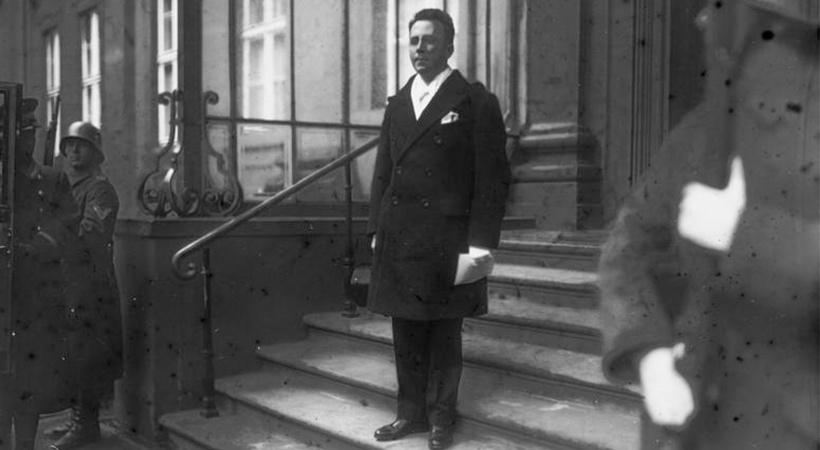1929
Mr Binchy goes to Berlin

This picture was taken around midday on Saturday 27th October 1929 on the steps of the Presidential Palace in Berlin. Daniel Binchy, a 30 year old scholar of Irish studies, has just presented his credentials to President Paul Von Hindenburg, becoming Ireland’s first Envoy Extraordinary and Minister Plenipotentiary to Germany.
He and President Von Hindenburg had conversed in German about the first East-West transatlantic flight the previous year, made from Baldonnel to Quebec in a German aircraft piloted by Hermann Kohl and James Fitzmaurice – a Dubliner and one of our own pioneer aviators. They spoke too about Ardnacrusha power station – Ireland’s great modernization project, undertaken with German assistance. Even in 1929, there were strong reasons to open a Legation in Berlin.
I am fascinated by Daniel Binchy. I admire him. He was a fine writer and a shrewd observer of human nature. He had heard Hitler speak when he was a student in Berlin eight years earlier, describing him to a friend as ‘a harmless lunatic with a gift for oratory’. His friend replied: ‘No lunatic with the gift of oratory is harmless’. Binchy could tell a story against himself that told a greater truth about his subject.
Sometime his insights glitter like the gems they really are. On Hitler: “There are only two barriers to megalomania in public life: intelligence and a sense of humour … I believe Hitler to be lacking in both”. And on his Ambassadorial colleagues in Berlin: “the smaller and more unimportant the country which a Minister represents, the more conscious he is of his great dignity….”
Binchy was a shy man, uncomfortable with the public dimension of his job. He confided to a friend that: "For me the round of social activities is an unceasing torment, I dodge them with increasing unscrupulousness when at all possible”. Of his British colleagues, he wrote: “I go to their various parties with fortitude, although I wish they would not give quite so many”.
There is a picture taken at the Irish Legation during a visit by Minister Patrick McGilligan in May 1931. It is probably the first image of an Embassy interior, complete with "Dun Emer carpets, Hicks furniture, Carrickmacross lace, and pictures (mostly lent by friends) by Lamb, Paul Henry, Jack Yeats, AE and Nathaniel Hone.” Binchy in a white tie and tails barely disguises his discomfort in the setting.
Even as he stood on the steps of the Presidential Palace that October morning, events were already in train that would eventually bring Hitler to power. Three days earlier, on Black Thursday 24th October, stocks had begun to fall on Wall Street. Its consequences were devastating for a German economy built on American loans and dependent on foreign trade. Fifteen years later, the Presidential Palace stood in ruins, a bombed out shell, the steps deserted.
By that time, Binchy had left Berlin and diplomatic life to return to academia and begin work on what is today his enduring monument – the Corpus of Early Irish Law, later published in 6 landmark volumes.
Always a fine writer, the diplomat turned academic, uncle of Maeve Binchy, reflected memorably on a life devoted to the study of Irish legal tracts.
“Many an investigator will leave his bones to bleach in that desert before it is accurately mapped. I had hoped to provide subsequent explorers with a very rough sketch map, but as things are, I can only offer them a ticket of admission to the desert."
A summary of a life’s work that’s typical of an unassuming man who left a considerable legacy in his three short years in Ireland’s fledgling diplomatic service.
Niall Burgess, Secretary General, Department of Foreign Affairs and Trade.


